Ferrari reveals hot and snazzy F8 Spider
Ferrari replaces the 488 Spider and improves on all aspects of its specifications; mid-rear-engined drop-top is powered by the most successful Ferrari V8 ever
Ferrari has unveiled the F8 Spider, the new generation drop-top sports car equipped with the most successful mid-rear-mounted V8 engine in history.
The Ferrari F8 Spider was designed in parallel with the F8 Tributo berlinetta and features the Prancing Horse’s compact and efficient RHT (Retractable Hard Top) which influences the lines of a model that leads its category. The RHT takes just 14 seconds to deploy or retract and can be closed or opened while the car is on the move up to 45kph.
The F8 Spider is the latest addition to an exclusive and prestigious bloodline of open-top V8 cars begun with the 308 GTS in 1977. It is less extreme than the 488 Pista Spider, but sportier than the 488 Spider which it replaces in the range.
According to the Italian sportscar manufacture, this Ferrari spider combines the characteristics of the most lauded 8-cylinder engine in history with unparalleled driving pleasure. The V8 raises the performance bar to unprecedented new heights, not only for turbo engines but power units of all types. The engine is a development of the V8 that won the ‘International Engine of the Year Award’ for four consecutive years (2016, 2017, 2018 and 2019) and that was also selected as the best engine of the last two decades.
The F8 Spider’s greatest achievement is the fact that it unleashes its power instantaneously with zero turbo lag, whilst retaining this V8’s unique and very special soundtrack. This astonishing performance and the car’s disarmingly effortless handling were made possible by integrating a series of innovative, track-derived aero solutions into its design, says Ferrari.
The F8 Spider replaces the 488 Spider and improves on all aspects of its specifications: aside from the fact that its engine delivers an extra 50 cv, the new Ferrari is 20kg lighter than its predecessor. It weighs just 20kg more than the more extreme 488 Pista Spider. The F8 Spider is significantly more aerodynamically efficient, too and features the new 6.1 version of the Side Slip Angle Control system.
The 3902cc V8 engine unleashes 720 cv at 8,000rpm and also has an impressive specific power output of 185 cv/l. Its maximum torque is now higher at all engine speeds, peaking at 770 Nm at 3,250 rpm. Maximum torque is 10 Nm higher than on the 488 Spider and is available even at lower engine speeds.
The F8 Spider’s engine also inherits highly efficient weight-reduction solutions from the 488 Pista which have cut the power unit’s weight by 18kg compared to that of the 488 Spider. Reducing the weight of rotating and non-static masses, such as the titanium con-rods, crankshaft and flywheel, allows engine speed to rise very rapidly. These reductions in the weight of the rotating masses yield a 17 percent reduction in inertia.
Inconel exhaust manifolds derived from the 488 Challenge alone contribute 9.7kg to the lighter engine weight. The exhaust layout has been extensively modified across the board from the turbos to the tail pipes to produce a sound absolutely unique to this particular car. The result is an unmistakable engine timbre that is superior in terms of both the intensity and quality of the sound. The exhaust line also features a new Gasoline Particulate Filter (GPF) to comply with new homologation requirements.
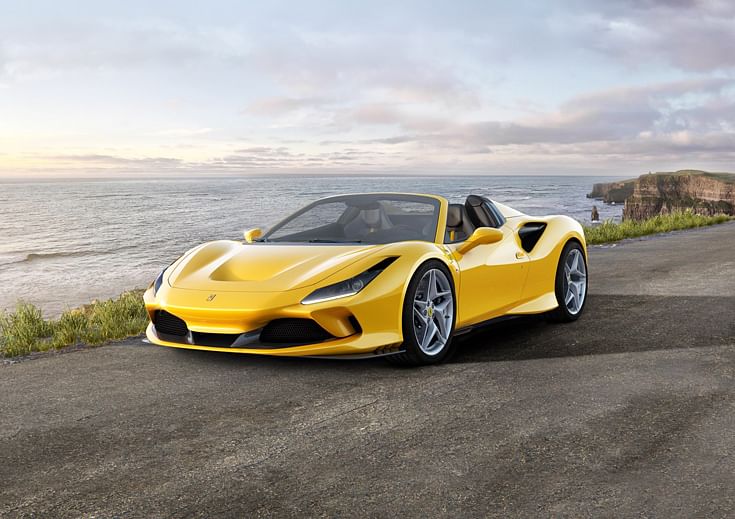
Looks fast when standing still
Designed by the Ferrari Styling Centre, the F8 Spider continues the direction embarked upon with the F8 Tributo which acted as a bridge to a new design language that will continue to emphasise Ferrari’s key characteristics of high performance and extreme aerodynamic efficiency.
When designing a spider, the choice of the top will always play a fundamental role in the car’s overall look. For some years now, Ferrari has been adopting a hard top because of the comfort it provides. As a result, the design of the F8 Spider’s lines was crafted around its RHT (Retractable Hard Top).
The key to the whole design was the shifting of the separation line between the car’s body and the roof from its conventional position at the belt-line (occupant shoulder level) to above the B-pillar. The top itself is thus more compact and two-dimensional, with the result that it can be divided into two parts and stowed on top of the engine.
The RHT takes just 14 seconds to deploy or retract and can be closed or opened while the car is on the move up to 45 km/h.
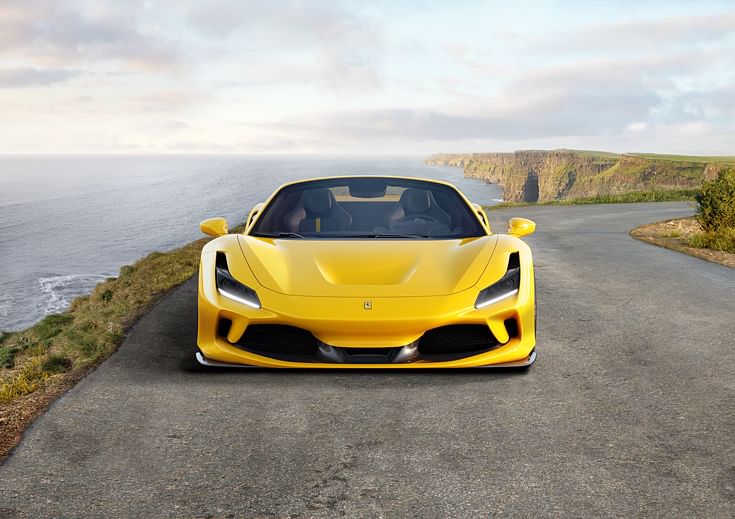
The front view of the car is characterised by the S-Duct around which the entire front end has been redesigned to highlight the extensive aerodynamic modifications made to this area of the car. The clearest example is new, more compact, horizontal LED headlights.
The rear spoiler has been entirely redesigned. It is now larger and wraps around the tail lights, visually lowering the car’s centre of gravity and allowing a return to the classic twin light cluster and body-coloured tail, another styling cue from the early 8-cylinder berlinettas like the very first in the legendary series, the 308 GTB.
The treatment of the engine cover is one of the F8 Spider’s most distinctive characteristics. The manta-like look of the cover is created by a central spine that starts from the rear screen and disappears under the wing of the blown spoiler, following the air flows themselves.
The two wings that emerge from the central volume meld harmoniously with the bodywork, lending a sense of visual continuity from all angles. These wing elements are suspended creating an air vent below them which helps improve dissipation of the heat coming off the engine. The three sculpted strakes on the side elements of the engine cover also make their own contribution to this, in addition to referencing the iconic styling of the rear screen of the coupé version. The strakes are finished in black to reduce weight low and to lend a sense of visual clarity to the design.
The crests that emerge from the prominent volumes of the tonneau cover fins flow sinuously rearwards and into the spoiler in an interpretation of the F1 “swan neck” (the pillars supporting the rear wings) which, in turn, enhances the already-powerfully sporty personality of the car.
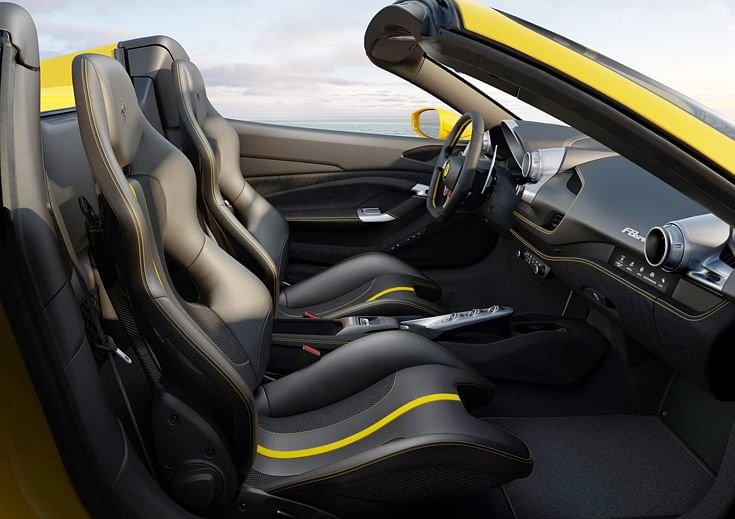
Seat of the pants
The F8 Spider’s cockpit retains the classic, driver-oriented look typical of Ferrari’s mid-rear-engined berlinettas. A concept that creates a symbiotic relationship between driver and car, very much as happens in F1, with all controls mounted on the new generation steering wheel. The sporty seats are also new.
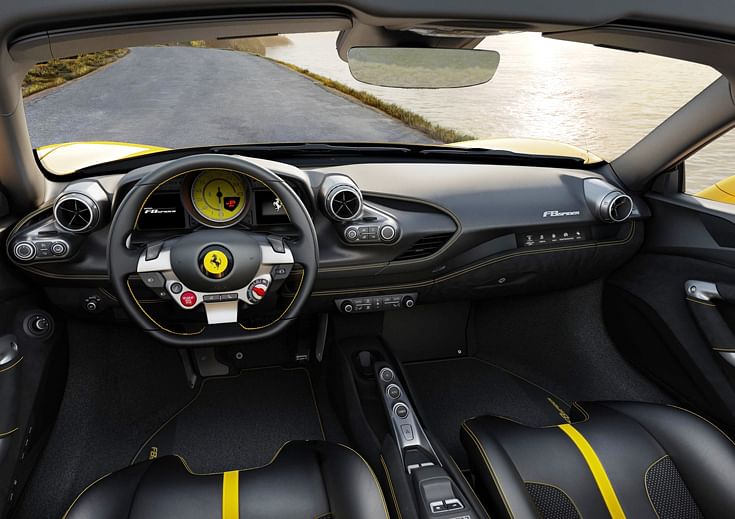
The dash incorporates an aluminium sail panel supporting the central satellite and continuing into the dash itself. Also to create a sense of visual lightness, a sliver of carbon fibre divides the upper and lower parts, streamlining the whole look. This section also incorporates the optional 7-inch touchscreen passenger-side display and the dash is completed by the classic instrument cluster with its central rev-counter.
The tunnel is clearly separated from the dash and set beneath it, once again to enhance the sensation of lightness that the car’s interior exudes. It features a new bridge, a prominent sculptural creation that seems to float and thus further streamlines the cabin.
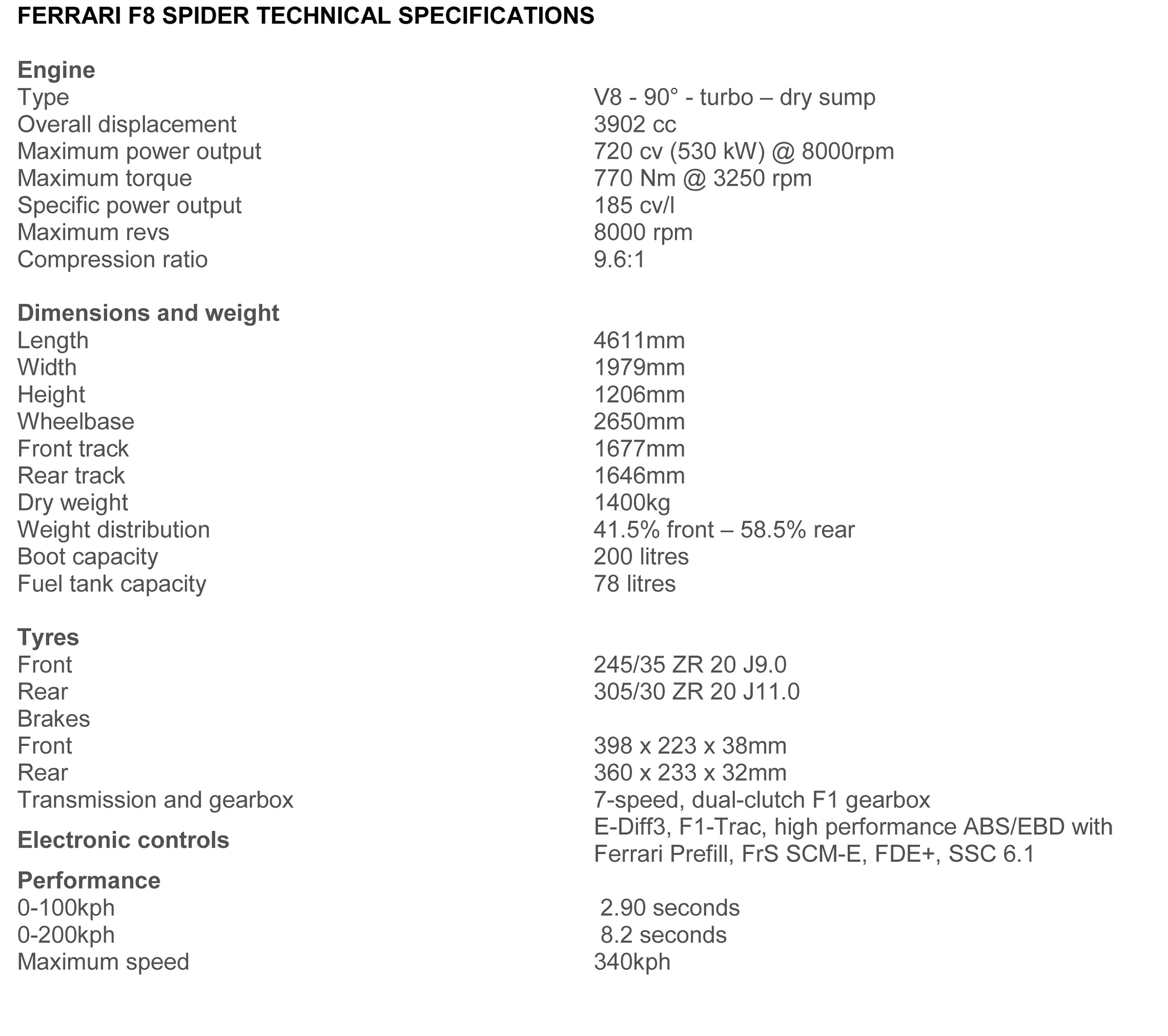
RELATED ARTICLES
Forvia Appning and 4screen partner to transform the onboard experience
The partnership aims to enrich the driver and passenger experience by providing personalized and contextual recommendati...
ZF unveils next-gen intelligent chassis sensor
Upgraded version’s integrated accelerometer enables even more precise detection of relative motion in three dimensions a...
First BYD EV rolls off the line at new plant in Brazil
Chinese EV maker takes just 15 months from breaking ground to producing the Dolphin Mini, the first locally manufactured...





 By Autocar Professional Bureau
By Autocar Professional Bureau
 09 Sep 2019
09 Sep 2019
 8763 Views
8763 Views


























